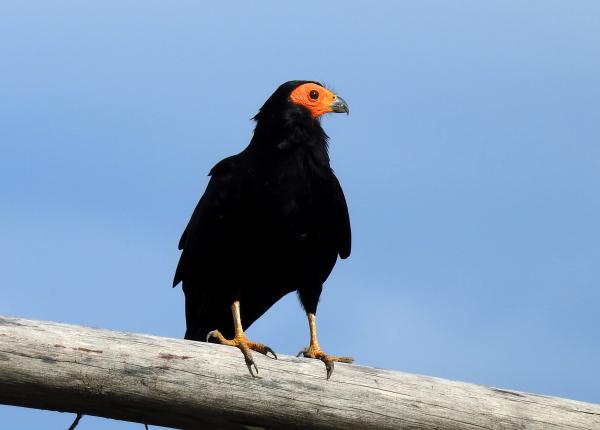Did You Know?
- The Black Caracara has a mutualistic relationship with tapirs. These caracaras can spend quite a bit of time picking ticks and other parasites from the tapirs' bodies. It is said that when tapirs hear Black Caracaras nearby, they emit a call that attracts the birds in to feed.
- A researcher in Ecuador observed a Black Caracara taking food from a Harpy Eagle nest that contained a 5-6 month old nestling. The caracara only took food when none of the adult Harpy Eagles were around.
How The Peregrine Fund is Helping
The Peregrine Fund doesn't work directly with Black Caracaras, but our efforts in scientific research, habitat conservation, education, and community development help conserve birds of prey around the world. We also supply literature to researchers from our avian research library, which helps scientists around the world gather and share important information on raptor conservation.
Where They Live
The Black Caracara is a Neotropical species found in South America, from Colombia through parts of Venezuela, the Guyanas Ecuador, Peru, Bolivia and Brazil. It makes its home in the low and middle elevations in humid forests, along forest edges, in wooded savannas, along river banks, in swamps, mangroves, and even near ranches.
What They Do
True to its name, the Black Caracara is decorated in beautiful shiny black feathers over most of its body. Its face is featherless and the bare skin ranges from orange to red. This diurnal bird of prey is quite vocal - and is often seen before it is heard. It often moves around in family groups of several birds. Researchers have described this species as being quite tame around people.
Why They Need our Help
The Black Caracara is characterized as a species of Least Concern. It is widespread throughout its range, however, there is a lot we still need to learn about the status of this species in many parts of its range Its population appears to be increasing in Ecuador as forested areas are newly cleared. There is some evidence that the reason it is absent from some seemingly good habitat in French Guiana may be due to human hunting pressure.
What They Eat
This species is omnivorous, meaning it eats both animal and plant matter. It has an extremely varied diet and will feed on anything from beetle larvae, to ants, amphibians, reptiles, songbird nestlings, small mammals, fish, carrion and some fruits. It picks ticks off tapirs and deer like other species may do from cattle. It also forages in areas that have been recently burned.
Nests, Eggs, and Young
There is still al lot for us to learn about the nesting behavior and biology of the Black Caracara. They build relatively small stick nests in the top of a large tree or in the middle of bromeliad, or even in palm trees. The eggs are an off white and marked with brownish spots. Not much else is known.
Black Caracara and the World Center for Birds of Prey
The World Center for Birds of Prey offers fun ways to learn about birds of prey. The visitor center offers interactive displays, tours, interesting videos and a children's room with activities from coloring sheets to quizzes to costumes and a touch table for the curious mind. We also have several different birds of prey on display year-around. Knowledgeable staff and volunteers are on hand to answer any questions you may have about Black Caracaras or any other birds of prey.
References:
Bierregaard, R. O., G. M. Kirwan, and P. F. D. Boesman (2020). Black Caracara (Daptrius ater), version 1.0. In Birds of the World (J. del Hoyo, A. Elliott, J. Sargatal, D. A. Christie, and E. de Juana, Editors). Cornell Lab of Ornithology, Ithaca, NY, USA. https://doi.org/10.2173/bow.blacar1.01
BirdLife International. 2016. Daptrius ater. The IUCN Red List of Threatened Species 2016: e.T22696226A93550476. https://dx.doi.org/10.2305/IUCN.UK.2016-3.RLTS.T22696226A93550476.en. Downloaded on 06 September 2021.
Global Raptor Information Network. 2021. Species account: Black Caracara Daptrius ater. Downloaded from http://www.globalraptors.org on 6 Sep. 2021









